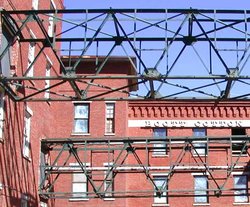Lowell National Historical Park
|
|
Lowell National Historical Park is a National Historical Park of the United States located in Lowell, Massachusetts. Established in 1978, it is operated by the National Park Service and comprises a group of different sites in and around the city of Lowell related to the era of textile manufacturing in the city during the 19th century.
| Contents |
History of the Park
See the Lowell, Massachusetts article for a detailed history of the city
First settled by whites in the 17th century, Lowell became an important manufacturing center along the Merrimack River in the early 19th century with the construction of several canals linking the Merrimack to the Charles River, which flows through Boston. Unlike many other mill towns, however, Lowell's manufacturing facitilities were built based on a planned community design. Specifically Lowell was planned as reaction to the mill communities in Great Britain, which were perceived as cramped and inhumane. Initially the factories of Lowell were built with ample green space and accompanying clean dormitories, in a style that anticipated such later architectural trends as the City Beautiful movement in the 1890s. Lowell attracted both immigrants from abroad and migrants from within New England and Quebec (including a large proportion of young women) who lived in the dormitories and worked in the mills.
The mill industry in Lowell went into a steep decline in the middle 20th century and by the 1960s, the city's manufacturing district was largely in ruins. Urban renewal plans called for the paving over of the canals. The idea of creating a historic district in Lowell was largely the idea of local teacher Patrick J. Mogan, whoinsisted that any revitalization of the city should be based on its industrial and ethnic heritage. Morgan believed that this was the soul of the city—and not incidentally, a key to its economic salvation. As a result, group of community organizations began cooperating on a comprehensive plan to renovate the historic heart of the city. In 1978, the United States Congress established Lowell National Historical Park and the Lowell Historic Preservation Commission. The legislation to create the park was sponsored by United States Senator and Lowell native Paul Tsongas. The restoration gathered momentum in the 1980s, including the renovation of the canals and former mill facilities into museums, as well as the construction of a waterfront walkway.
Description
The park includes a Visitor's Center, as well as many restored and unrestored sites from the 18th century. The Visitor's Center provides a free self-guided tour of the history of Lowell, including display exhibits such as the patent model of a loom by local inventor S. Thomas.
A footpath along the Merrimack Canal from the Visitor's Center is lined with plaques describing the importance of various existing and former sites along the canal. The Boott Mill along the river, the most full restored manufacturing site in the district, provides a walk-through museum with living recreations of the textile manufacturing process in the 19th century. The walking tour includes a detour the memorial to local author Jack Kerouac, who described the mid-20th century declined state of Lowell in several of his books. A walkway along the river leads to several additional unrestored mill sites, providing views of restored and unrestored canal raceways once used by the mills.
See also
External link
- National Park Service site (http://www.nps.gov/lowe/2002/home.htm)

